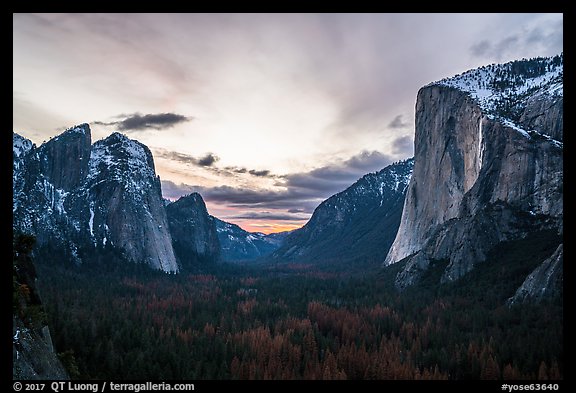Which is the Best Photo of Horsetail Fall Firefall?
No Comments
I wrote previously about finding a new view of Horsetail Fall, Yosemite “natural firefall”. The high vantage point let me frame the waterfall in a rich wide-angle composition that brought me much satisfaction. But would most people consider it to be “better” than the classic photograph? What would their relative preferences say?
On the day I finally photographed Yosemite’s Horsetail Fall firefall, I had started to hike late after walking in the Valley with my friend Theresa for most of the day. The first reason is that the day before, I had already scouted the location and figured out my favorite composition. More open views were available from spots below the wall, on a high scree slope with a large opening above the trees. From there, no rock wall obscured Cathedral Rocks from nicely balancing El Capitan for a “reverse Tunnel View”, and those spots were also much safer from falling ice and rocks. The photograph below was made after sunset, when the glow was gone.

Although getting close to the rock wall obscured Cathedral Rocks, this was more than compensated for by the foreground seasonal waterfall providing depth to the image, and with the frozen crust, an additional contrast of fire and ice. That would have been enough, but I like to find something extra. That less obvious ingredient was the reflected glow on the wet rock, and to capture it with breathing room, I needed to stand right at the base of the wall, at the most dangerous spot. Refer to this post for the resulting image.
My second reason for starting late was that on the previous day, a Thursday, there was only another photographer at the location. Maybe because it was a Friday, the next day, to my surprise, the number had grown to at least two dozen. Most of them appeared to frame the open view, but I noticed a few including the waterfall, and subsequently, a friend pointed out to me two such shots posted on Flickr, although without the left glow. Small world! The number of photographers up the hill was still a far cry from the hundreds gathered in the two much smaller viewing areas on the valley floor.
It could be some had scrambled up the slope so that they would escape the circus, but maybe they also went up for the wider view, which would have indicated that my thinking was far from unique amongst dedicated photographers. The firefall had been shot more than forty years ago, and I had seen hundreds of images so it was a familiar sight to me, although I had never seen it in person before. Like for other well-worn subjects, I thought it would be more interesting to state its presence without making it the obvious and sole center of attention of the photograph. Compare the bold framing of El Capitan by Carleton Watkins, and the more sophisticated photographs by Ansel Adams, or look at how many current renditions of landmarks use a wide-angle composition where said landmark occupies a relatively small portion of the frame.

One of the advantages of positioning yourself for a wide-angle view is that you can always shoot a tigher composition from the same vantage point, while the reverse isn’t true. Because the firefall lasted only a few minutes, I did not have time to change my position to shoot the “reverse Tunnel View”, however I briefly switched from a wide angle lens (35mm) to a telephoto lens (300mm) to shoot a more direct composition of the firefall filling the frame.
I did not think much of that image, which was not the main goal of my outing, but nevertheless posted it on social media sites. On Instagram, the wide-angle composition got 213 likes versus 99 likes for the tight view. But on Google+ the wide-angle composition got 115 likes and 2 shares, while the tight view got 173 likes and 13 shares. Those numbers represent a small sample and may not be meaningful, but what if they were? I tried to think, past my initial puzzlement, about the implications.
If you had never seen the firefall, the tighter view would be more impressive because it gives you a clearer representation of the event in all its glory. And if you came to see the firefall, the tighter view would remind you more of what you came to see. Instagram is a platform entirely dedicated to sharing photos, and as such its demographic includes a high proportion of photographers. Google+ is a more general-interest platform whose typical user is less likely to post photos.
Most dedicated nature photographers are aware of the firefall, but the general public is not. For photographers, the firefall is a mature subject for which an indirect approach is preferred since a straightforward photograph seems unoriginal. For the general public, the firefall is a not mature subject, and they may prefer a direct, textbook-like representation. Even if they have been at the event, it is the awesomeness of it that they remember. As a photographer, it is easy to overestimate the exposure, and therefore maturity of a subject, especially if one’s social interactions are mainly with other photographers. This could be why the iconic views of the national parks can be dissed by some photographers, while they continue to be admired by the general public. The photographers want to see the photograph, but the general public wants to see the subject. Some photographers cringe at slot canyon photographs, but in the while Peter Lik makes millions out of them – even from a single print sale, but that would be another topic. Besides being an art, photography is a form of communication, and one cannot ignore the composition of their audience.
Did you experience instances where your audience’s reaction did not go with your personal preference? And was the wide-angle composition the best photo of Horsetail Fall Firefall?

